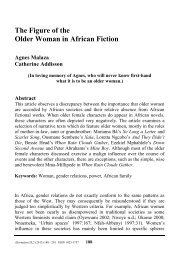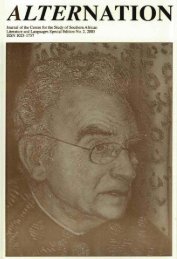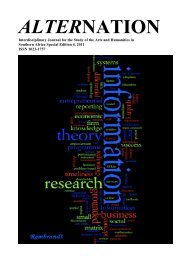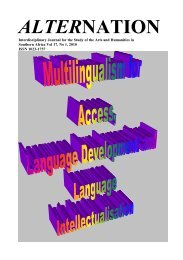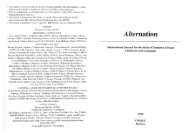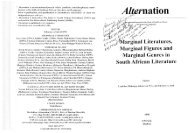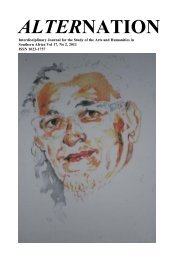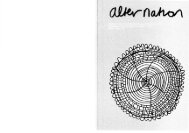Shane Moran - Alternation Journal
Shane Moran - Alternation Journal
Shane Moran - Alternation Journal
You also want an ePaper? Increase the reach of your titles
YUMPU automatically turns print PDFs into web optimized ePapers that Google loves.
urrent lrends in the Prodzdction ofSozlth Afi~cnn Histoo)<br />
The TRC thus constitutes a moment and a space where the field of history appears to be<br />
open to reinterpretation and meaning. Clearly the TRC has many different parts with<br />
different meanings and implications for history production. Giving testimony and<br />
participating in the public space of the hearings does provide a profound sense of<br />
'giving voice' to previously marginal and silenced accounts of the apartheid past. In<br />
important respects these activities elevate subaltern accounts into those of society as a<br />
whole. These accounts then have the potential to break down divisions between<br />
subaltern and elite accounts, particularly where those divisions are drawn in racial<br />
terms. 111 this sense the TRC served to directly open up public historical discourse to<br />
members of formally oppressed communities in ways that also move beyond the<br />
institutional sites ofprofessional historical production.<br />
The official collection of personal testimony within the TRC also provides for<br />
the construction of a national archive of subaltern experience on a scale that is<br />
enormously significant for the future production of history. Here people have spoken<br />
about their own historical initiatives and meanings as active historical agents in a past<br />
that will potentially attain the fullness of a national history. official, public *and<br />
academic relationships to this archive and understandings of this national history will<br />
however vary.<br />
At the outset of the TRC, the media depicted the TRC as performing the larger<br />
role of new national and subaltern historian. 'From the outset, the principal aim of the<br />
commission has been to unearth South Africa's hidden history during the three decades<br />
which followed the banning of the liberation movements', said Busii?ess Day. Other<br />
newspapers produced similar interpretations. The TRC, they claimed would now 'tell<br />
the whole sto~y' in the 'search for truth' by incorporating previously 'silenced voices'.<br />
This would open up the rewriting of South Afiican history in ways which will 'set<br />
[ordinary black people] free from the prisons of uncertainty in which the ghastly events<br />
of the past have confined them for too long'. The TRC at the outset, then, was seen to<br />
represent<br />
South Africa's real history ... it's most important look at the past painful 50<br />
years ... [tlor the first time, ail South Africa has the opportunity to learn the<br />
uncensored truth about itshistoryi'.<br />
Through its collection of testimony at the various hearings around the country, history<br />
was being primarily rewritten through 'devastating testimony', 'police brutality tales',<br />
Business DOJJ 12141 1996. 6/51 1996: CiOi Press 6/51 1996; h4ail and G1,nrtliarz 10-<br />
161511 996: ,-fi~z~,s 4-5/51 1996: Szlndq~ Tiines 51511 996: SII~~CIJJ Indepencierzf 5/5/1996;<br />
.Yoivetciil 10- I 6151l 996. for exam~>le. fiadio broadcasts on SA12M provided cvtensive covcsagc<br />
oftlie I'RC:, using a broadly siniilar Si-aiiicwoi-k of Iiidde~i. ordina~y. rcal and new. often with<br />
insc~.lcd voices to givc thc kc1 of th~s register--one whicll is 1.cprocfrrczt1 as well in thc daily live<br />
broadcasts on Radio 2000.<br />
Muvtzn Legcrsslck and (;111.1) i~znklej~<br />
'speaking the unspeakable', through ordinary words. The range of codes and moods is<br />
unusually explicit and connective in these accounts: hidden, ordinary, oral, marginal,<br />
real, objective and 'new'--told and heard for the first time. There is more than an ironic<br />
echo here to the explanations of social history 'from below', but in a way which<br />
simultaneously ignores the existing contributions of this social historiography to<br />
having already detailed important aspects of this so-called hidden history. Instead the<br />
public and official spaces of the TRC are represented as the key sites for the emergence<br />
of this new history at this time.<br />
This early representation of the TRC hearings and activities as the new 'real'<br />
and 'hidden' history, though, also needs to be qualified in various ways. The TRC itself,<br />
has explicitly argued it will be 'writing a history ofa certain kind' which was to 'capture<br />
the perspectival nuances of the drama [of human rights violations]' in as<br />
'comprehensive an account as possible"3. The TRC's framework is the period 1960-<br />
1994 and its focus, then, is not simply the entire past of this period, but to obtain<br />
as complete a picture as possible of the nature, causes and extent of gross<br />
violations of human rights committed during the pel-iod ... emanating torn<br />
the conflicts of the past-".<br />
This 'history of a certain kind' is also influenced by the concern to 'promote national<br />
unity and reconciliation in a spirit of understanding which transcends the conflicts and<br />
divisions of the past"'This meant that the TRC accounts of the past would need to<br />
acknowledge '... some kind of compromise between those who want amnesia-to<br />
forget the past-and those who are saying "let us have revenge, retribution""! All thesc<br />
are constraints on the TRC's mode of representation of the past.<br />
Over the period of the TRC's existence there have been a range of further<br />
contests which have influenced a range of changingfocuses of attention from within the<br />
TRC, imposing further such constraints. These have involved families of victims,<br />
perpetrators, political parties, legal andjudicial challenges and 'outsider' cr~tiques and<br />
refusals of active participation in the process. The shift of TRC and public attention<br />
from victim to amnesty hearings, recently highlighted by the Winnie Mandela and PW<br />
Botha cases, has also meant a shift fi-om ordinary narratives of the past to more legal,<br />
interrogative and statist 'top-down' accounts which are increasingly concerned with<br />
conspiracy, silence and evasion about the past. This seems a far call from the initial<br />
media conceptions which celebrated hidden histories of ordinary people telling the<br />
whole story.<br />
More particularly for our concell1 here, this means that the potential oEcial<br />
I'<br />
Cl~arles Villa-Vicencio, Director of Research at TRC Workshop, ULVC, 3 April 1996.<br />
"<br />
Pro~notion ofNational Unity and Reconciliation Act, Government Gazette 26 July (1995) 2.<br />
'' TRC Regiorzcrl T64orkshop.s Docu~zent nd: I.<br />
'\rchbishop DesmondcTutu. WeekendArgzl.~ 2012 1 January (1 996).



